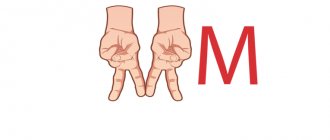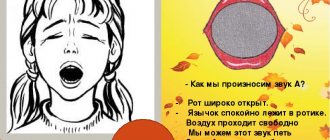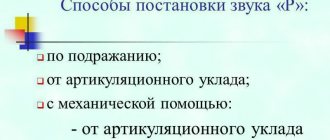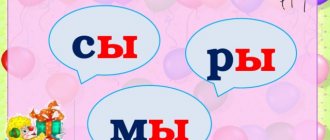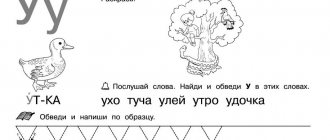Certificate for children
Learning to read is one of the most important tasks for a preschooler. Having mastered this skill, the child will be able to independently explore the world with the help of books and find answers to his questions.
Development and education of children from 2 to 11 years old in a playful way
Start practicing right now
Start practicing
However, this is not so easy to learn. We suggest using game techniques that will help turn a difficult learning process into an exciting quest.
Preparing older preschoolers for literacy training. Consultation for parents
Consultation for parents (educators) “Preparing senior preschool children for learning to read and write”
Description of the material: I offer you a consultation on the topic: “Preparing senior preschool children for learning to read and write.” This material will be useful to speech therapists, speech pathologists, teachers and parents of children of older preschool age. The use of these methods and techniques contributes to the development of children's development of sound and letter analysis of words used in a playful form and familiarization with the rules for performing sound analysis of words. Goal: development of sound-letter analysis and synthesis of words. Literacy learning is a deliberate, systematic process to prepare for mastery of writing and reading. The teacher believes that teaching literacy to preschool children is necessary because: - the requirements of primary school have become higher, and many parents are sincerely interested in teaching children to read; - many difficulties have arisen in teaching children to write and read at school; - not all children cope with the pace proposed by the school curriculum; — physiological and psychological readiness for schooling is formed long before entering school and does not end in the first grade. Teaching literacy in kindergarten is a propaedeutic for dyslexia and dysgraphia and will help the child avoid some specific mistakes. It is important that the child: • does not miss letters or mix them up when writing; • knew how to use his hearing, vision, pronunciation to identify identifying features of vowels and consonants, voiced and voiceless consonants, and not only; tried to remember the corresponding letters; • under the guidance of a teacher, he formed a cognitive attitude towards speech, clarifying and expanding his vocabulary. There are several main components that are included in the process of learning to read and write: Formation of the sound side of speech, i.e. the child must have correct, clear pronunciation of sounds of all phonemic groups (whistles, hisses, sonors); • Full formation of phonemic processes, i.e. the ability to hear, distinguish and differentiate the sounds of the native language; • Readiness for sound-letter analysis and synthesis of the sound composition of speech, i.e. isolate the initial vowel from the word; analysis of vowel sounds; analysis of reverse syllables; hear and highlight the first and last consonant sound in a word: Introducing children to the terms: “sound”, “syllable”, “word”, “sentence”, sounds vowels, consonants, hard, soft, deaf, voiced. To develop the ability to work with word patterns, split alphabet and master syllabic reading skills. “How to teach children the sound analysis of words” Teaching children to read and write in kindergarten is carried out using the analytical-synthetic method. This means that children are introduced to the sounds of their native language first and then to the letters. When teaching both writing and reading, the initial process is the sound analysis of oral speech, that is, the mental division of a word into its constituent sounds, establishing their quantity and sequence. Children with problems in speech development, who have impaired pronunciation of phonemes and their perception, especially experience difficulties in sound analysis and synthesis. They can be expressed to varying degrees: from mixing the order of individual sounds to a complete inability to determine the number, sequence or position of sounds in a word. Teaching the sound analysis of a word is the main task of the preparation stage for teaching literacy and involves: - determining the number of sounds in a word; - phonetic characteristics of sounds (the ability to differentiate vowels and consonants, voiced and voiceless, hard and soft); - determining the place of a sound in a word. Dear teachers (parents), remember: 1. Sound - we hear and pronounce. 2. We write and read letters. 3. Sounds are vowels and consonants. Vowel sounds can be sung with a voice, while the air coming out of the mouth does not meet any obstacles (vowels can be sung to the tune of any song). Consonant sounds are sounds that cannot be sung, because the air coming out of the mouth when pronouncing them meets a barrier in the form of lips, teeth, and palate. There are six vowel sounds: A U O I E Y There are ten vowel letters: A U O I E Y - correspond to the sounds and four are iotized, which indicate two sounds: Ya-ya, Yu-yu, E-ye, Yo-yo. Vowel sounds are indicated in red on the diagram. Consonant sounds are voiced and unvoiced. A dull sound is formed without the participation of vocal folds; we explain to children that when we pronounce a dull sound, the voice sleeps, and when pronouncing voiced sounds, the voice rings (put your hand on the neck or cover your ears with your hands). Voiceless sounds: K, P, S, T, F, X, Ts, Ch, Sh, Shch, Consonant sounds are soft and hard. Always hard consonants: Zh, Sh, Ts. Always soft consonants: Y, Ch, Shch. Hard sounds are indicated in the diagrams in blue, soft sounds in green. Sample game tasks. 1. “Traffic lights” Task: to develop auditory attention, phonemic hearing. The adult calls the sound, and the child raises the blue or green traffic light. Then the word. If you hear a hard sound at the beginning of a word, you need to raise the blue square, if it’s soft, you need to raise the green one (Snow, winter, skiing, etc.). 2. “Show a picture of a certain sound” (hear the sound at the beginning of the word) 3. “Sound train” (identify the sound at the beginning and end of the word) 4. “How many sounds are hidden in the word?” 5. “Place of sound in a word” How is the sound analysis of a word carried out? Post a diagram of the word CAT. — How many sounds are in the word CAT? (There are three in the word CAT - What is the first sound in the word CAT? (the first sound is [K]) - What is the sound [K]? (The sound [K] is consonant, unvoiced, hard.) - What square on the diagram will we denote the sound [K]? (Blue square). - What is the second sound in the word CAT? (Second sound [O]) - What is the sound [O]? (The sound [O] is a vowel). - What square on the diagram will indicate the sound [O]? (Red square) . - What is the third sound in the word CAT? (The third sound is [T]). - What is the sound [T]? (The sound [T] is consonant, hard, unvoiced). Which square on the diagram will indicate the sound [T]? (Blue square ) - The sounds became friends. What happened? (CAT). Letters are a graphic symbol of sounds. Often we are faced with the fact that children are taught letter-by-letter reading, that is, children, seeing a letter, pronounce its name, and not the sound: pe, re.. The result is “keote”, instead of “cat". Children have difficulty understanding the rules of voicing letters and letter combinations. This creates additional difficulties in teaching children to read. The method of teaching reading in kindergarten involves naming letters by their sound designations: p, b, k…. This makes it much easier for children to master reading skills. In order for the child to better understand the graphic appearance of the letter and to prevent dysgraphia at school (dysgraphia is a written language disorder), the following tasks are recommended: - “What does the letter look like?” — In a series of letters, circle the given letter. — Laying out letters from counting sticks, from string on velvet paper, sculpted from plasticine, etc. - Circle the letter by dots, shade the letter, complete the letter. Dear teachers (parents), follow the teachers’ instructions very carefully when completing assignments, do not complicate the assignments at your own discretion. Remember that the requirements of the kindergarten and the family must be the same! I wish everyone good luck! Used literature: 1. Bugrimenko E.A., Zhedek P.S., Tsukerman G.A. Teaching reading according to the system of D. B. Elkonin. Methodical manual for the Primer. - M.: Education, 2003. 2. Bystrova G.A., Sizova E.A., Shuiskaya T.A. Speech therapy games and tasks. St. Petersburg: “Karo”, 2002. 3. Zhurova L.E. Teaching preschoolers literacy. - M.: School - Press, 1998. 4. Mazanova E.V. Correction of dysgraphia due to violations of language analysis and synthesis. - M., 2006. 5. Mazanova E.V. Forms and methods of speech therapy work for the correction of dysgraphia // Development and correction.-2001. 6. Tkachenko T.A. Speech therapy notebook. Development of phonemic awareness and sound analysis skills. – St. Petersburg, 2005. 7. Filicheva T.B., Tumanova T.V. Children with phonetic-phonemic underdevelopment. Education and training. Educational and methodological manual for speech therapists and educators. -M.: "Publishing house GNOM and D", 2000. -80 p.
We recommend watching:
Scenario of a game program for teaching literacy to children in the preparatory group Didactic game for teaching literacy to older preschoolers Didactic game for teaching literacy to older preschoolers Notes on teaching literacy in the preparatory group
Similar articles:
Summary of a lesson on teaching literacy in the preparatory group
Summary of a lesson in the preparatory group on the development of speech and literacy
Literacy games for children 4-5 years old
Literacy games for children 5-6 years old in kindergarten
Educational games for children 6-7 years old in kindergarten. Card index
Literacy training in the senior group
It is at the age of 5-6 years that children usually begin to actively teach literacy and spend time developing speech: distinguishing sounds and letters, reading individual words and sentences, putting emphasis.
Preschoolers learn to find the right words to name objects in pictures, make sentences, and draw diagrams of words.
Children also train and prepare their hands for writing: they draw and paint a lot, shade, trace the contours of objects, and learn to write letters little by little.
Benefits of classes:
- These classes will enable the child to better acquire knowledge about the variety of sounds and letters;
- will form ideas about words and that words consist of sounds;
- will be a good assistant in the formation of phonemic hearing (the ability to hear and distinguish sounds in speech);
- With the help of adults, children will learn to distinguish sounds in speech, and therefore pronounce them correctly.
- Completing these tasks will help prepare children for learning to read and write in the senior group of kindergarten and in preparation for school.
Each lesson is located on 2 sheets of A4 format. You can print on two sheets, or on one - a page on each side. Total, 50 sheets - 50 full-fledged lessons on developing the pronunciation side of speech and teaching literacy.
The classes are developed based on our website. On the site you will find colorful illustrations, games and exercises to help with the printouts.
Instructions included.
Each lesson contains detailed instructions on how to complete the tasks. Tasks include: a description of the sound being studied, a graphic representation of a letter, a copy of letters, many illustrations of sounds and other interesting material.
In order for the child to find it both interesting and useful at the same time, the classes are supplemented with numerous coloring books . This is both visibility for the child and the development of fine motor skills of the fingers . Let us remind you that it is better to color with triangular pencils: they fit better in the child’s fingers.
Literacy cards
Each exercise consists of a short sentence and five tasks required to complete. A sentence is a short text. There are usually no problems with reading and understanding it. Sentence texts are not repeated; they are easy to come up with yourself.
The question is often asked: why repeat a sentence you read? Children who are beginning to read concentrate on the reading process itself, poorly understanding the content. Setting the stage for repetition after reading helps, from our point of view, to include understanding of the text.
The first time you need to do the exercise together. And then be sure to check the correctness of execution and sort out errors (if any). This is another plus: you learn the techniques of independent work. The longest word is determined by the number of letters.
The card looks like this.
In any editor, you can change the sentence, leaving the assignments. Get a new card. For example.
Lisa drew a picture.
Exercise.
1. Read the sentence and repeat it out loud.
2. Copy the longest word
3. Count how many words are in the sentence and write it in the empty square.
4. Divide the words into syllables.
5. In each word, place a red dot with a felt-tip pen under the vowels, a blue dot under the hard consonants, and a green dot under the soft consonants.
Example of completing a (partial) task


